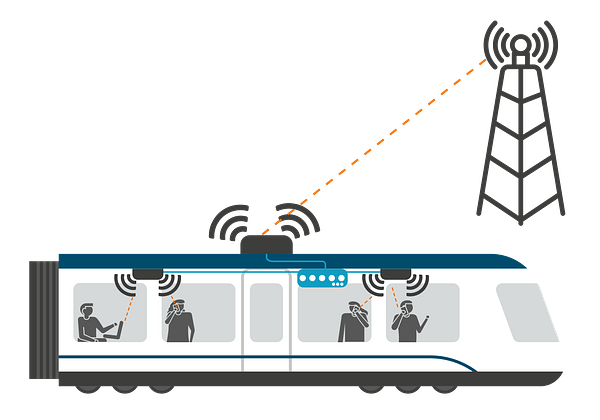
Author: (this will open in a new window)Steve Smith, Principal Consultant

As passengers increasingly rely on digital lifelines for work, leisure, and staying connected, the inadequacy of onboard Wi-Fi has become a pressing issue.
The government and rail operators are encouraging the public to use the train wherever possible, and I am “on board” with that, particularly for those longer journeys where you can use the time to work whilst travelling. However, my personal experience reveals that current onboard connectivity falls short. Despite flights to London often being faster and cheaper—usually half the price—the productivity gains from train travel outweigh any potential savings. Additionally, trains are a lot more environmentally friendly and rely on passenger numbers to bolster operator viability. Nevertheless, the reality is disappointing, with train Wi-Fi quality and consistency woefully lacking.
You may remember the Department for Transport (this will open in a new window)announcement to cut funding for rail Wi-Fi last year. The Government’s advice to rail companies was to stop providing the service unless they can demonstrate its business case, further threatening the survival of the already unstable Wi-Fi service.
And at FarrPoint, we do believe there is a business case for improving Wi-Fi connectivity on trains.
Of the numerous train journeys I’ve undertaken for business purposes, to meet clients, and to attend or speak at conferences and events, I can confidently say that almost all those journeys have had some issue with the onboard Wi-Fi, meaning all the productivity benefits of travelling by train are often reduced or lost entirely.
So what’s behind these problems? Well, there are two factors to consider – the onboard Wi-Fi itself and how it is used and getting connectivity to the train in the first place.
The Wi-Fi itself poses a challenge, frequently failing to function as expected and requiring multiple sign-in attempts to accept terms and conditions. Now, I don’t set my stopwatch to time how long this typically takes, but let’s just say any sign-in process that takes from Newcastle to Durham to work is probably not working as well as it should.
Unfortunately, the problems don’t stop there. Once connected, passengers are all competing for the available bandwidth. While one passenger catches up on their favourite TV show, another attempts to join a Teams call, and I struggle to open a Word document, none of us are having much success.
This leads to another challenge: getting connectivity to the train so that passengers can actually use the Wi-Fi. Mobile operators' coverage maps can lack accuracy and fail to indicate the network capacity essential for delivering the desired quality of Wi-Fi service. Consequently, trains along these routes encounter significant connectivity fluctuations. While there has been investment in enhancing mobile connectivity, further efforts are needed.
A solution we often attempt in order to avoid the onboard Wi-Fi is to tether to our phone or to “hotspot”. However, this isn’t a fool proof solution for two reasons. Firstly, even maintaining a voice call on a train for any period of time can be difficult; anyone who has tried will attest to it not being the most reliable connection. Secondly, and more fundamentally, the phone is connected to a single mobile network, whereas a train can access all four mobile networks to maintain connectivity and smooth out those inevitable not spots. So, in simple terms, if a train with dedicated external antennas can’t maintain a good quality of service, how can my lowly phone inside the big metal signal-blocking tube be expected to?

To achieve this, we need to adopt a fresh perspective on how we provide the standard of Wi-Fi connectivity on trains that aligns with passengers' expectations.
Much is said about the critical role of digital connectivity for our future economic, social, and sustainability success. That is why the UK Government has invested billions of pounds to ensure widespread access to superfast and gigabit connectivity across the nation, working in partnership with mobile networks to extend coverage to eliminate not spots.
However, careful consideration still needs to be given to how coverage can be improved along these vital mass-transit corridors. We must explore beyond historic constraints and consider alternative technologies, such as using LEO satellites for backhaul or how private 5G networks could cost-effectively meet both operational and passenger needs.
Tried-and-tested options, such as the 'freemium' model found in select venues and hotels, offer a basic free service while allowing users to upgrade for additional features. Similarly, long-haul flights offer paid Wi-Fi services with customisable pricing based on time allowances or service levels. Trains shouldn’t be an exception, and many countries across the world already offer reliable Wi-Fi services onboard.
However, regardless of the chosen approach, it's clear that action is essential to enhance the current Wi-Fi service on trains. Without improvements, passengers may increasingly seek alternative modes of transportation—cheaper, faster, more convenient, or more comfortable—potentially jeopardising the sustainability of our national rail networks.
At FarrPoint, we're not just about pointing out problems without seeking solutions. We're eager to exchange ideas with fellow interested parties dedicated to enhancing Wi-Fi connectivity aboard rail or other transport networks. If you're ready to talk about the possible solutions or need help building the business case, reach out to discuss how, together, we can enhance the travel experience for the millions.
Connectivity is important. It drives business and society, bringing communities and commerce together. That's why we use our insight and experience to connect people and business.